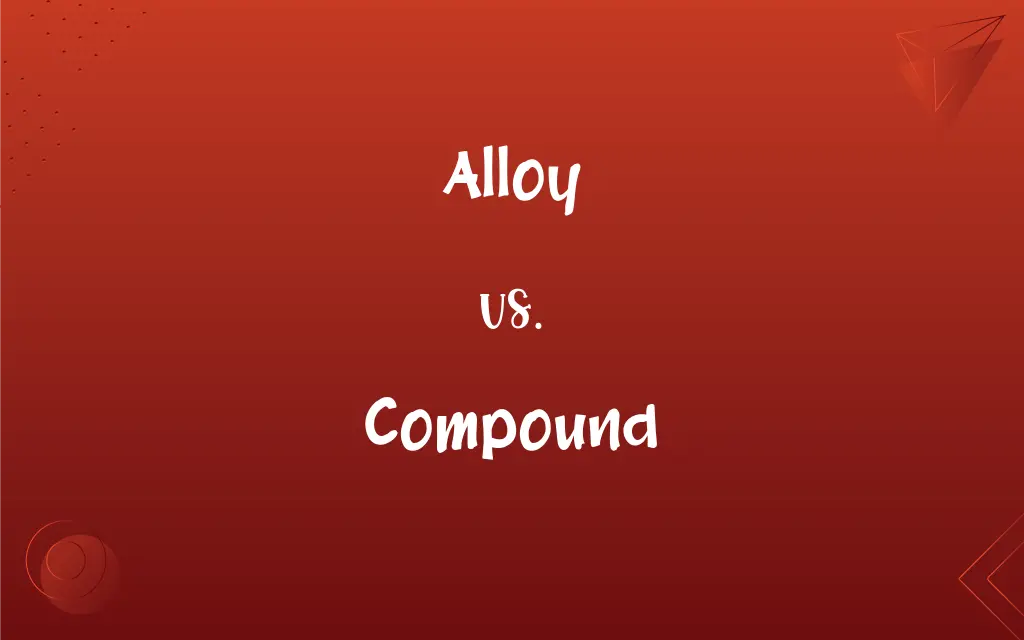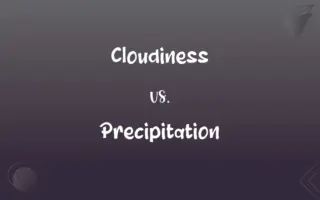Alloy vs. Compound: What's the Difference?
Edited by Aimie Carlson || By Harlon Moss || Updated on October 14, 2023
An alloy is a mixture of two or more metals, while a compound is a substance formed from two or more elements chemically combined in fixed ratios.

Key Differences
An alloy is essentially a blend of two or more metals, sometimes with non-metals, created to enhance specific properties of those metals. A compound, however, is a unique substance formed when two or more different elements combine chemically in specific ratios. While alloys maintain the individual properties of their constituent metals, compounds possess properties different from their constituent elements.
The creation of an alloy involves merely melting the constituent metals and mixing them. In contrast, a compound is formed through a chemical reaction, leading to the elements bonding together. Thus, while alloys display the physical merging of metals, compounds result from a chemical union of elements.
Alloys are typically designed to improve the strength, corrosion resistance, or other properties of metals. For instance, bronze, an alloy of copper and tin, is harder than either of its components. On the other hand, the properties of a compound are often entirely distinct from its constituent elements. For example, water (H₂O) is a compound with properties unlike either hydrogen or oxygen.
In the realm of separability, alloys can often be separated into their individual metals through physical processes like distillation. However, compounds usually require chemical reactions to be broken down into their constituent elements. This distinction underlines the physical nature of alloys and the chemical nature of compounds.
To illustrate with familiar examples, stainless steel is an alloy consisting mainly of iron with carbon, nickel, and chromium, while salt (NaCl) is a compound formed from sodium and chlorine. The former is an enhanced metal with combined characteristics, while the latter results in a substance distinctly different from its components.
ADVERTISEMENT
Comparison Chart
Nature
Mixture of metals.
Chemical combination of elements.
Formation
Physical mixture.
Chemical reaction.
Properties
Retains individual metal properties.
Exhibits new properties.
Separation
Can be separated physically.
Requires chemical processes.
Examples
Bronze, stainless steel.
Water (H₂O), salt (NaCl).
ADVERTISEMENT
Alloy and Compound Definitions
Alloy
An alloy might contain non-metals in small amounts.
Some alloys incorporate carbon for added hardness.
Compound
Compounds exhibit properties different from their constituent elements.
Sodium chloride, a compound, is edible, while sodium alone is not.
Alloy
Alloys are created to enhance specific metal properties.
Steel is an alloy designed for increased strength.
Compound
A compound is formed when elements combine chemically.
Water is a compound made from hydrogen and oxygen.
Alloy
Alloys are physical mixtures, not chemical compounds.
Solder, an alloy of tin and lead, melts at a lower temperature than its constituents.
Compound
Compounds have fixed ratios of their constituent elements.
The compound carbon dioxide always has one carbon and two oxygen atoms.
Alloy
An alloy is a blend of two or more metals.
Bronze is an alloy of copper and tin.
Compound
Compounds result from chemical reactions.
Combining sodium and chlorine results in the compound salt.
Alloy
Alloys often possess combined characteristics of their components.
Stainless steel, an alloy, resists rusting due to its composition.
Compound
Breaking down compounds usually requires chemical processes.
To separate water into hydrogen and oxygen, one needs an electrolysis process.
Alloy
A metallic solid or liquid that is composed of a homogeneous mixture of two or more metals or of metals and nonmetal or metalloid elements, usually for the purpose of imparting or increasing specific characteristics or properties
Brass is an alloy of zinc and copper.
Compound
To combine so as to form a whole; mix
Tin was often compounded with lead to make pewter.
Alloy
A mixture; an amalgam
"Television news has ... always been an alloy of journalism and show business" (Bill Moyers).
Compound
To produce or create by combining two or more ingredients or parts; compose or make up
Pharmacists compounding prescriptions.
FAQs
Why are alloys created?
Alloys are designed to improve specific properties like strength or corrosion resistance.
Can alloys contain non-metals?
Yes, some alloys might include small amounts of non-metals.
How is an alloy different from a compound?
An alloy is a physical mixture of metals, while a compound is a chemical combination of elements.
Is water an alloy or a compound?
Water is a compound formed from hydrogen and oxygen.
How is a compound formed?
A compound is formed when two or more elements combine chemically in fixed ratios.
How can compounds be broken down?
Compounds usually require chemical reactions for separation.
Is it easier to separate an alloy or a compound?
Typically, it's easier to separate an alloy since it's a physical mixture, whereas compounds require chemical processes.
Can you provide an example of an alloy?
Bronze, made of copper and tin, is a classic example of an alloy.
Are the ratios of elements in a compound important?
Yes, the specific ratios dictate the compound's identity and properties.
Why can't we call an alloy a compound?
Because an alloy is a physical mixture of metals, not a chemical combination of elements.
Is rust an alloy or a compound?
Rust is a compound, specifically iron oxide.
What is an alloy?
An alloy is a mixture of two or more metals, often designed to enhance certain properties.
Do compounds always have different properties than their elements?
Yes, compounds typically exhibit properties distinct from their constituent elements.
Can alloys be separated into their constituent metals?
Yes, alloys can often be separated using physical processes.
Can an alloy contain three or more metals?
Absolutely, alloys can contain multiple metals and even non-metals.
Do alloys always improve the properties of metals?
Not always, but they are often designed to enhance certain characteristics like strength or resistance.
Can the properties of compounds be predicted from their elements?
Not always, compounds often have properties very different from their individual elements.
What makes compounds unique from mixtures?
Compounds have elements combined in fixed ratios and exhibit distinct properties, unlike mixtures.
Which is more common in everyday life, alloys or compounds?
Both are common; alloys are prevalent in construction and machinery, while compounds are found in substances like water and salt.
What determines the characteristics of an alloy?
The type and ratio of constituent metals and the method of production play a significant role.
About Author
Written by
Harlon MossHarlon is a seasoned quality moderator and accomplished content writer for Difference Wiki. An alumnus of the prestigious University of California, he earned his degree in Computer Science. Leveraging his academic background, Harlon brings a meticulous and informed perspective to his work, ensuring content accuracy and excellence.
Edited by
Aimie CarlsonAimie Carlson, holding a master's degree in English literature, is a fervent English language enthusiast. She lends her writing talents to Difference Wiki, a prominent website that specializes in comparisons, offering readers insightful analyses that both captivate and inform.
































































